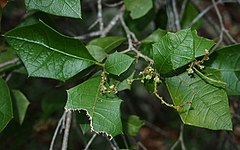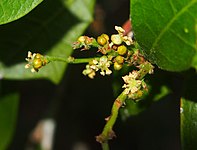Alchornea ilicifolia
| Native holly | |
|---|---|

| |
| At Mount Archer National Park | |
| Scientific classification | |
| Kingdom: | Plantae |
| Clade: | Tracheophytes |
| Clade: | Angiosperms |
| Clade: | Eudicots |
| Clade: | Rosids |
| Order: | Malpighiales |
| Family: | Euphorbiaceae |
| Genus: | Alchornea |
| Species: | A. ilicifolia
|
| Binomial name | |
| Alchornea ilicifolia | |
| Synonyms[3] | |
|
Homotypic Heterotypic | |
Alchornea ilicifolia, commonly known as the native holly, is a bush of eastern Australia. It grows in or on the edges of the drier rainforests in coastal parts of New South Wales and Queensland.
Description
[edit]The native holly is a shrub or rarely a small tree up to 6 m (20 ft) tall. The trunk is usually crooked, with pale grey smooth bark, and some pustules and lenticels. Small branches are greenish or fawn in colour, with paler lenticels.[4][5] The leaves are holly-like in appearance, 2 to 8 cm (0.8 to 3 in) long and 2 to 5 cm (0.8 to 2 in) wide.[4][5][6] They are ovate or rhomboidal in shape with three or four acute lobes on each side, each of which is armed with a sharp spine.[4][5][6] They are stiff and glabrous with a petiole around 3 mm (0.1 in) long.[4][5][6]
Flowers and fruit
[edit]Greenish flowers appear in November, on racemes up to 5 cm (2 in) long, with male and female flowers on separate plants.[4][5][6] The fruit is a dark brown, three-lobed capsule about 6 to 8 mm (0.2 to 0.3 in) in diameter, each lobe containing one seed.[4][5][6] The plant may flower and fruit at any time of year after rain events.[5]
Taxonomy
[edit]The botanist John Smith originally described this species as Caelebogyne ilicifolia in 1839, from three specimens collected by Allan Cunningham in 1829.[7] The Swiss botanist Johann Müller gave it its current name in 1865.[2] The generic name Alchornea honours the English botanist Stanesby Alchorne,[8] while the species epithet ilicifolia refers to the holly-like leaves (Ilex).
Distribution and habitat
[edit]This species grows in vine thickets and monsoon forest on a variety of soil types, from Jamberoo on the south coast of New South Wales to Atherton in far north Queensland.[4][5][6]
Ecology
[edit]Alchornea ilicifolia is a host plant for the larvae of the common albatross butterfly and the moth Dichomeris mesoctenis.[9][10]
Gallery
[edit]-
Flowers
-
Flowers
-
Unripe fruit
-
Habit
References
[edit]- ^ "Species profile—Alchornea ilicifolia". Queensland Department of Environment and Science. Queensland Government. 2022. Retrieved 31 March 2023.
- ^ a b "Alchornea ilicifolia". Australian Plant Name Index (APNI). Centre for Plant Biodiversity Research, Australian Government. Retrieved 31 March 2023.
- ^ a b "Alchornea ilicifolia (Js.Sm.) Müll.Arg". Plants of the World Online. Royal Botanic Gardens, Kew. Retrieved 31 March 2023.
- ^ a b c d e f g "PlantNET - FloraOnline". PlantNET (The NSW Plant Information Network System). Royal Botanic Gardens and Domain Trust, Sydney. Retrieved 31 March 2023.
- ^ a b c d e f g h Forster, Paul I. (2022). Moon, C.; Orchard, A.E. (eds.). "Alchornea ilicifolia". Flora of Australia. Australian Biological Resources Study, Department of Climate Change, the Environment and Water: Canberra. Retrieved 31 March 2023.
- ^ a b c d e f F.A.Zich; B.P.M.Hyland; T.Whiffen; R.A.Kerrigan (2020). "Alchornea ilicifolia". Australian Tropical Rainforest Plants Edition 8 (RFK8). Centre for Australian National Biodiversity Research (CANBR), Australian Government. Retrieved 31 March 2023.
- ^ Smith, John (1839). "Notice of a Plant which produces perfect Seeds without any apparent Action of Pollen". Transactions of the Linnean Society of London. 18 (4): 509. doi:10.1111/j.1095-8339.1838.tb00200.x. Retrieved 31 March 2023.
- ^ Cooper, Wendy; Cooper, William T. (June 2004). Fruits of the Australian Tropical Rainforest. Clifton Hill, Victoria, Australia: Nokomis Editions. p. 171. ISBN 9780958174213.
- ^ "Alchornea ilicifolia (EUPHORBIACEAE); Native holly". Archived from the original on 26 June 2010. Retrieved 21 March 2010.
- ^ Robinson, Gaden S.; Ackery, Phillip R.; Kitching, Ian; Beccaloni, George W.; Hernández, Luis M. (2023). "HOSTS". HOSTS - a Database of the World's Lepidopteran Hostplants. Natural History Museum. Retrieved 31 March 2023.
External links
[edit]- View a map of historical sightings of this species at the Australasian Virtual Herbarium
- View observations of this species on iNaturalist
- View images of this species on Flickriver




